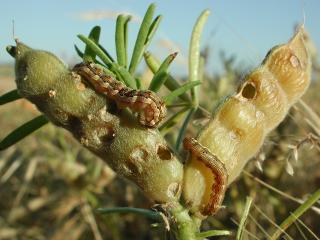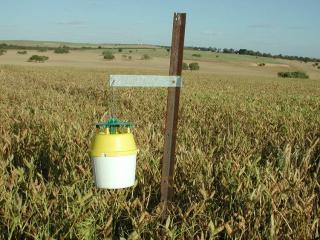Native budworm activity. Trapping has finished for the season
Caterpillar activity
- Williams
- Tambellup
Plant pathologist Kylie Chambers has recently reported finding high levels of native budworm caterpillars and associated feeding damage in canola and lupin plots at a trial site at Williams.
A grower near Tambellup has reported finding budworm caterpillars in his cereals but was not too concerned given the very low amount of damage that was evident.
Entomologist Dusty Severtson (DPIRD) advises growers and consultants to identify caterpillars. If they are native budworm then sweep net and monitor damage as cereals are not a host and they are unlikely to cause economic damage. For more information refer to DPIRD’s 2019 PestFax Issue 19 article Native budworm update and likely reasons behind high numbers this season and their presence in cereal crops.
Native budworm moth trapping surveillance has concluded
Many of the volunteer farmers, agronomists and DPIRD staff who have been trapping native budworm moths this season have packed away their traps because crops are too advanced to be troubled by future moth egg laying.
Their efforts in sending in weekly reports to PestFax and providing advanced warning of the budworm threat are greatly appreciated.
The automated native budworm moth trap surveillance has also concluded for the season.
Native budworm moths generally move westward looking for less advanced crops as the eastern crops dry out, and continue migrating in search of other host plants such as pasture and vegetables.
All late maturing crops and legume pastures should be checked for budworm caterpillars, especially in areas where moth numbers have been recorded 3-4 weeks ago.
This season’s automated and manual trappings are available for viewing at the department’s Native budworm moth numbers 2019.
Be mindful of withholding periods near harvest
Farmers with native budworm caterpillars in their crops need to be mindful of insecticide withholding periods (WHP) close to harvest and remember that swathing/windrowing is classified as harvest.
For more information on insecticides refer to the department’s Winter/Spring Insecticide Spray Chart 2019.
For more native budworm moth information contact Alan Lord, Technical Officer, South Perth on +61 (0)8 9368 3758 or +61 (0)409 689 468.
Article authors: Alan Lord (DPIRD South Perth), Dusty Severtson (DPIRD Northam) and Cindy Webster (DPIRD Narrogin).


